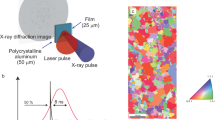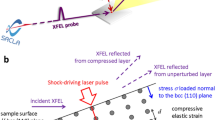Abstract
Pressure-driven shock waves in solid materials can cause extreme damage and deformation. Understanding this deformation and the associated defects that are created in the material is crucial in the study of a wide range of phenomena, including planetary formation and asteroid impact sites1,2,3, the formation of interstellar dust clouds4, ballistic penetrators5, spacecraft shielding6 and ductility in high-performance ceramics7. At the lattice level, the basic mechanisms of plastic deformation are twinning (whereby crystallites with a mirror-image lattice form) and slip (whereby lattice dislocations are generated and move), but determining which of these mechanisms is active during deformation is challenging. Experiments that characterized lattice defects8,9,10,11 have typically examined the microstructure of samples after deformation, and so are complicated by post-shock annealing12 and reverberations. In addition, measurements have been limited to relatively modest pressures (less than 100 gigapascals). In situ X-ray diffraction experiments can provide insights into the dynamic behaviour of materials13, but have only recently been applied to plasticity during shock compression14,15,16,17 and have yet to provide detailed insight into competing deformation mechanisms. Here we present X-ray diffraction experiments with femtosecond resolution that capture in situ, lattice-level information on the microstructural processes that drive shock-wave-driven deformation. To demonstrate this method we shock-compress the body-centred-cubic material tantalum—an important material for high-energy-density physics owing to its high shock impedance and high X-ray opacity. Tantalum is also a material for which previous shock compression simulations18,19,20 and experiments8,9,10,11,12 have provided conflicting information about the dominant deformation mechanism. Our experiments reveal twinning and related lattice rotation occurring on the timescale of tens of picoseconds. In addition, despite the common association between twinning and strong shocks21, we find a transition from twinning to dislocation-slip-dominated plasticity at high pressure (more than 150 gigapascals), a regime that recovery experiments cannot accurately access. The techniques demonstrated here will be useful for studying shock waves and other high-strain-rate phenomena, as well as a broad range of processes induced by plasticity.
This is a preview of subscription content, access via your institution
Access options
Access Nature and 54 other Nature Portfolio journals
Get Nature+, our best-value online-access subscription
$29.99 / 30 days
cancel any time
Subscribe to this journal
Receive 51 print issues and online access
$199.00 per year
only $3.90 per issue
Buy this article
- Purchase on Springer Link
- Instant access to full article PDF
Prices may be subject to local taxes which are calculated during checkout




Similar content being viewed by others
References
Ashworth, J. R. & Schneider, H. Deformation and transformation in experimentally shock-loaded quartz. Phys. Chem. Miner. 11, 241–249 (1985)
French, B. & Koeberl, C. The convincing identification of terrestrial meteorite impact structures: what works, what doesn’t, and why. Earth Sci. Rev. 98, 123–170 (2010)
Gattacceca, J., Lamali, A., Rochette, P., Boustie, M. & Berthe, L. The effects of explosive-driven shocks on the natural remanent magnetization and the magnetic properties of rocks. Phys. Earth Planet. Inter. 162, 85–98 (2007)
Draine, B. T. & Salpeter, E. E. Destruction mechanisms for interstellar dust. Astrophys. J. 231, 438–455 (1979)
Pappu, S., Kennedy, C., Murr, L. E., Magness, L. S. & Kapoor, D. Microstructure analysis and comparison of tungsten alloy rod and [001] oriented columnar-grained tungsten rod ballistic penetrators. Mater. Sci. Eng. A 262, 115–128 (1999)
Thoma, K., Schafer, F., Hiermaier, S. & Schneider, E. An approach to achieve progress in spacecraft shielding. Adv. Space Res. 34, 1063–1075 (2004)
Chen, M. W., McCauley, J. W., Dandekar, D. P. & Bourne, N. K. Dynamic plasticity and failure of high-purity alumina under shock compression. Nat. Mater. 5, 614–618 (2006)
Murr, L. E. et al. Shock-induced deformation twinning in tantalum. Acta Mater. 45, 157–175 (1997)
Hsiung, L. L. & Lassila, D. H. Shock-induced deformation twinning and omega transformation in tantalum and tantalum-tungsten alloys. Acta Mater. 48, 4851–4865 (2000)
Lu, C. H. et al. Laser compression of monocrystalline tantalum. Acta Mater. 60, 6601–6620 (2012)
Florando, J. N., Barton, N. R., El-Dasher, B. S., McNaney, J. M. & Kumar, M. Analysis of deformation twinning in tantalum single crystals under shock loading conditions. J. Appl. Phys. 113, 083522 (2013)
Lu, C. H. et al. Laser compression of nanocrystalline tantalum. Acta Mater. 61, 7767–7780 (2013)
Loveridge-Smith, A. et al. Anomalous elastic response of silicon to uniaxial shock compression on nanosecond time scales. Phys. Rev. Lett. 86, 2349–2352 (2001)
Suggit, M. J. et al. Nanosecond white-light Laue diffraction measurements of dislocation microstructure in shock-compressed single-crystal copper. Nat. Commun. 3, 1224 (2012)
Milathianaki, D. et al. Femtosecond visualization of lattice dynamics in shock-compressed matter. Science 342, 220–223 (2013)
Comley, A. J. et al. Strength of shock-loaded single-crystal tantalum [100] determined using in-situ broadband. Phys. Rev. Lett. 110, 115501 (2013)
Wehrenberg, C. E. et al. Lattice-level observation of the elastic-to-plastic relaxation process with subnanosecond resolution in shock-compressed Ta using time-resolved in situ Laue diffraction. Phys. Rev. B 92, 104305 (2015)
Rudd, R. E . et al. Theory and simulation of 1D to 3D plastic relaxation in tantalum. AIP Conf. Proc. 1426, 1379 (2012)
Higginbotham, A. et al. Molecular dynamics simulations of shock-induced deformation twinning of a body-centered-cubic metal. Phys. Rev. B 88, 104105 (2013)
Tramontina, D. et al. Molecular dynamics simulations of shock-induced plasticity in tantalum. High Energy Density Phys. 10, 9–15 (2014)
Meyers, M. A. Dynamic Behavior of Materials Ch. 14 (John Wiley and Sons, 1994)
McGonegle, D., Milathianaki, D., Remington, B. A., Wark, J. S. & Higginbotham, A. Simulations of in situ X-ray diffraction from uniaxially compressed highly textured polycrystalline targets. J. Appl. Phys. 118, 065902 (2015)
Fleischer, R. L. Single crystal lattice rotation during compression. J. Mech. Phys. Solids 6, 301–306 (1958)
Miljacic, L., Demers, S., Hong, Q.-J. & van de Walle, A. Equation of state of solid, liquid and gaseous tantalum from first principles. Calphad 51, 133–143 (2015)
Lu, C. H., Hahn, E. N., Remington, B. A., Maddox, B. R. & Meyers, M. A. Phase transformation in tantalum under extreme laser deformation. Sci. Rep. 5, 15064 (2015)
Ravelo, R., Germann, T. C., Guerrero, O., An, Q. & Holian, B. L. Shock-induced plasticity in tantalum single-crystal: interatomic potentials and large-scale molecular-dynamics simulations. Phys. Rev. B 88, 134101 (2013)
Barton, N. R. et al. A multiscale strength model for extreme loading conditions. J. Appl. Phys. 109, 073501 (2011)
Philipp, H. T., Hromalik, M., Tate, M., Koemer, L. & Gruner, S. M. Pixel array detector for X-ray free electron laser experiments. Nucl. Instrum. Methods A 649, 67–69 (2011)
Mitchell, A. C. & Nellis, W. J. Shock compression of aluminum, copper, and tantalum. J. Appl. Phys. 52, 3363 (1981)
Meyers, M. A. Dynamic Behavior of Materials Ch. 5 (John Wiley and Sons, 1994)
Brown, J. M. & Shaner, J. W. in Shock Waves in Condensed Matter—1983 (eds Asay, J. R. et al.) 91 (Elsevier, 1984)
Kalidindi, S. R. Incorporation of deformation twinning in crystal plasticity models. J. Mech. Phys. Solids 46, 267–290 (1998)
Higginbotham, A. & McGonegle, D. Prediction of Debye–Scherrer diffraction patterns in arbitrarily strained samples. J. Appl. Phys. 115, 174906 (2014)
Plimpton, S. Fast parallel algorithms for short-range molecular dynamics. J. Comput. Phys. 117, 1–19 (1995)
Kimminau, G. et al. Simulating picosecond x-ray diffraction from shocked crystals using post-processing molecular dynamics calculations. J. Phys. Condens. Matter 20, 505203 (2008)
Acknowledgements
We thank P. Mirkarimi and C. Davis for preparing the targets. This work was performed under the auspices of the US Department of Energy by Lawrence Livermore National Laboratory under contract number DE-AC52-07NA27344, and Los Alamos National Laboratory under contract number DE-AC52-06NA25396. Use of the Linac Coherent Light Source (LCLS), SLAC National Accelerator Laboratory, is supported by the US Department of Energy, Office of Science, Office of Basic Energy Sciences under contract number DE-AC02-76SF00515. The MEC instrument is supported by the US Department of Energy, Office of Science, Office of Fusion Energy Sciences under contract number SF00515. This material is based on work supported by the US Department of Energy, Office of Science, Office of Fusion Energy Sciences, under award number DE-SCW-1507. J.S.W. is grateful to the UK EPSRC for support under grant EP/J017256/1. D.M. and M. Sliwa were supported by LLNS under contract numbers B595954 and B609694, respectively.
Author information
Authors and Affiliations
Contributions
The experiments were conceived by C.E.W., D.M., B.A.R., A.H., M.Su., R.E.R. and J.S.W., and were performed by C.E.W., D.M., B.A.R., A.H., J.S.W., H.-S.P., D.S., A.L., C.B., H.J.L., B.N. and F.T. The data were analysed by C.E.W., D.M., A.L. and M. Sliwa and the results were interpreted by C.E.W., D.M., M. Suggit, A.H., B.A.R., J.S.W. and R.E.R. Molecular dynamics simulations were performed by D.M., A.H., L.Z.-R. and R.E.R. The manuscript was written by C.E.W., B.A.R., R.E.R., J.S.W. and D.M.
Corresponding author
Ethics declarations
Competing interests
The authors declare no competing financial interests.
Additional information
Publisher's note: Springer Nature remains neutral with regard to jurisdictional claims in published maps and institutional affiliations.
Extended data figures and tables
Extended Data Figure 1 Diffraction angle (2θ) versus X-ray counts averaged over 2π in azimuthal angle for a shock pressure of 73 GPa.
The indices of the ambient pattern, which match the bcc phase with lattice parameter a = 3.308 Å, are marked in green. The driven pattern (black dots) matches the bcc phase with a = 3.051 Å. Indexed peak positions for the hexagonal phase are marked with red lines, and peaks corresponding to the ‘rumpled’ structure9 are marked with an asterisk. The bcc and hexagonal phases both overlap the observed peaks, but additional peaks are expected for the hexagonal phase that are not observed.
Extended Data Figure 2 Diffraction pattern for a 73-GPa shock.
The left panel shows the raw data; the bcc and hexagonal phases are overplotted on the right. The ambient bcc phase is marked in blue. The compressed and rotated bcc phase is marked in black, and the expected positions of the hexagonal phase are marked in white.
Extended Data Figure 3 Example VISAR streak image for a 130-GPa shock using a 250 μm phase plate.
The planar region of the shock, which is roughly similar in dimensions to the phase plate, breaks out of the tantalum free surface at 7.4 ns. The X-ray beam probes a 20-μm region in the centre of the planar shock.
Rights and permissions
About this article
Cite this article
Wehrenberg, C., McGonegle, D., Bolme, C. et al. In situ X-ray diffraction measurement of shock-wave-driven twinning and lattice dynamics. Nature 550, 496–499 (2017). https://doi.org/10.1038/nature24061
Received:
Accepted:
Published:
Issue Date:
DOI: https://doi.org/10.1038/nature24061
This article is cited by
-
A Review of the Anomalous Dynamic Behavior in Magnesium Alloys
JOM (2024)
-
Atomistic Simulations of Ductile Failure in a b.c.c. High-Entropy Alloy
High Entropy Alloys & Materials (2023)
-
Phase transformation path in Aluminum under ramp compression; simulation and experimental study
Scientific Reports (2022)
-
Virtual diffraction simulations using the quasi-coarse-grained dynamics method to understand and interpret plasticity contributions during in situ shock experiments
Journal of Materials Science (2022)
-
Deformation twinning to dislocation slip transition in single-crystal tantalum under dynamic compression
Journal of Materials Science (2022)
Comments
By submitting a comment you agree to abide by our Terms and Community Guidelines. If you find something abusive or that does not comply with our terms or guidelines please flag it as inappropriate.



